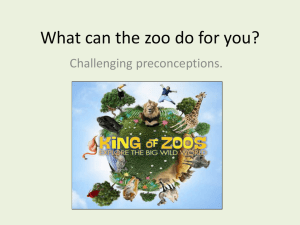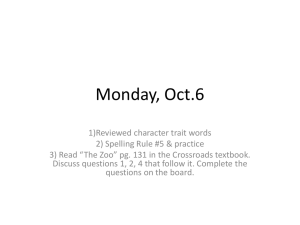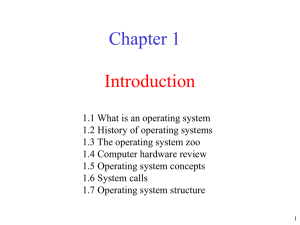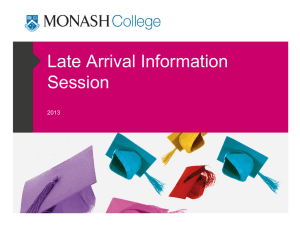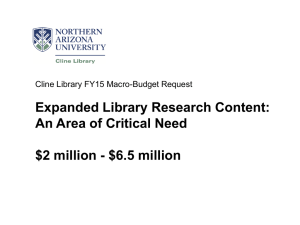Zoo Deficiency request presentations-senate
advertisement
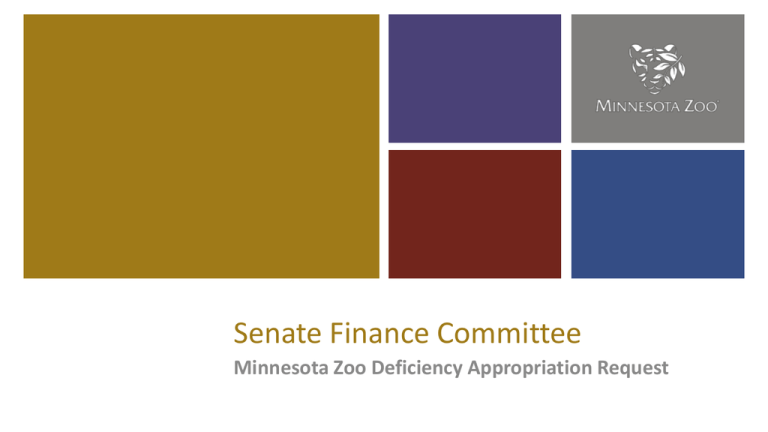
Senate Finance Committee Minnesota Zoo Deficiency Appropriation Request Minnesota Zoo’s Current Financial Situation • FY15 anticipated expenses will exceed projected revenues by $1.5 million • Available cash will be depleted by early Spring • A relatively small but significant additional investment by the State will stabilize the Zoo’s finances this year Trends Leading to the Current Situation General fund support for core Zoo operations is at historic low: • Zoo’s FY15 general fund appropriation, $5.425 million, covers only 22% of the expenses of the Zoo’s $25 million budget • The national average for annual public operating support for accredited zoos = 34% Expenses are rising—and likely to continue to rise—in all categories, with most beyond the Zoo’s control Earned revenues (almost 60% of budget) are historically volatile—and most recently have not met projections. Charitable giving (< 10% of budget) cannot feasibly be increased to replace all lost earned revenue Attendance and Revenue • 2014 winter, spring and summer attendance below original projections and shortfalls cannot now be made up in this fiscal year • Marginal changes in attendance have a direct impact on earned revenue as attendance accounts for almost 60% of budgeted revenues • Attendance drivers—weather, price, new exhibits/attractions, competition, general economic conditions—are not all in the Zoo’s control • Admission pricing at ceiling Timing of Current Financial Issues • Costs pressures of FY14 → aggressive attendance and earned revenue projections in budgeting for FY15 • Polar vortex, cold and snowy spring, wet June, sluggish July and August → attendance and earned revenues below projections for FY14 and early FY15 • Extent of earned revenue problems emerged in Q1 of FY15 What the Zoo is doing: Revenue • • • Increasing private support through Zoo Foundation contributions: Increase from $2.0 million to $2.25 million in contributions for Zoo operations now budgeted for FY15 with additional increases planned for future years Commitment to raise funds for future capital projects Driving attendance through new exhibits/attractions: Re-opening Discovery Bay and adding privately-funded Hanifl Family Wild Woods Play Area in FY15 Pursuing bonding to complete Heart of the Zoo 2 Diversifying revenue mix What the Zoo is doing: Expenses Zoo operating costs are fixed. It costs the same to operate the Zoo for 600 or 6,000 guests • FY14: Realigned and reduced expenses to accommodate increasing costs, including significant compensation and utility cost increases • FY15: Original budget included $400,000 in expense reallocations and reductions from prior year to accommodate increased costs • FY15, Q1: $500,000 direct expense reductions: Implemented staff layoffs Reduced non-salary costs Holding vacant positions open (where possible) Deferring site maintenance Consequences of No Deficiency Appropriation • Staff layoffs—approximately 36+ FTEs • Closing exhibits → impacts on admissions → impacts on revenue • Continued expenses: Animal care and feeding Providing for the safety and security of the Zoo’s visitors Delayed budget impacts of employee reductions Consequences of Deficiency Appropriation • Continued $146 million economic impact, 26 to 1 return on investment • Preserve and enhance the State’s investment in its Zoo


